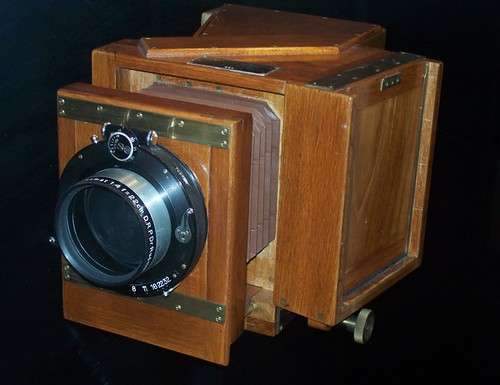Difference between revisions of "Bermpohl Naturfarbenkamera"
m (→specifications) |
(semipermeable is a term usually associated with a chemical diffusion process) |
||
| Line 6: | Line 6: | ||
}} | }} | ||
| − | The '''Naturfarbenkamera''' (natural | + | The '''Naturfarbenkamera''' (natural color camera) is a typical three-color camera made by [[Bermpohl|Bermpohl & Co., Berlin]]. A system of beam-splitting mirrors divides the incoming light into three identical light bundles projecting the image onto three film plates, enabling them to be exposed simultaneously. Color filters in front of each film plate renders the black-and-white image suitable for a three-color printing process. The beam-splitting process was mainly in use from early to the middle of the twentieth century, being replaced by color film photography later on. |
| − | ==== | + | ====Specifications==== |
| − | *Type: | + | *Type: Color camera using three monochrome film plates |
*Manufacturer: Bermpohl & Co., Berlin | *Manufacturer: Bermpohl & Co., Berlin | ||
*Film: three black-and-white film plates | *Film: three black-and-white film plates | ||
*Lens: 1:4/220mm | *Lens: 1:4/220mm | ||
| + | *Lens aperture range: 1:4 to 1:32 | ||
*Shutter: compound shutter with speeds up to 1/50 sec. | *Shutter: compound shutter with speeds up to 1/50 sec. | ||
| − | |||
[[Category: Three-color]] | [[Category: Three-color]] | ||
[[Category: B]] | [[Category: B]] | ||
Revision as of 15:09, 27 July 2009

|
| wood construction for bellows and three film plates |
The Naturfarbenkamera (natural color camera) is a typical three-color camera made by Bermpohl & Co., Berlin. A system of beam-splitting mirrors divides the incoming light into three identical light bundles projecting the image onto three film plates, enabling them to be exposed simultaneously. Color filters in front of each film plate renders the black-and-white image suitable for a three-color printing process. The beam-splitting process was mainly in use from early to the middle of the twentieth century, being replaced by color film photography later on.
Specifications
- Type: Color camera using three monochrome film plates
- Manufacturer: Bermpohl & Co., Berlin
- Film: three black-and-white film plates
- Lens: 1:4/220mm
- Lens aperture range: 1:4 to 1:32
- Shutter: compound shutter with speeds up to 1/50 sec.